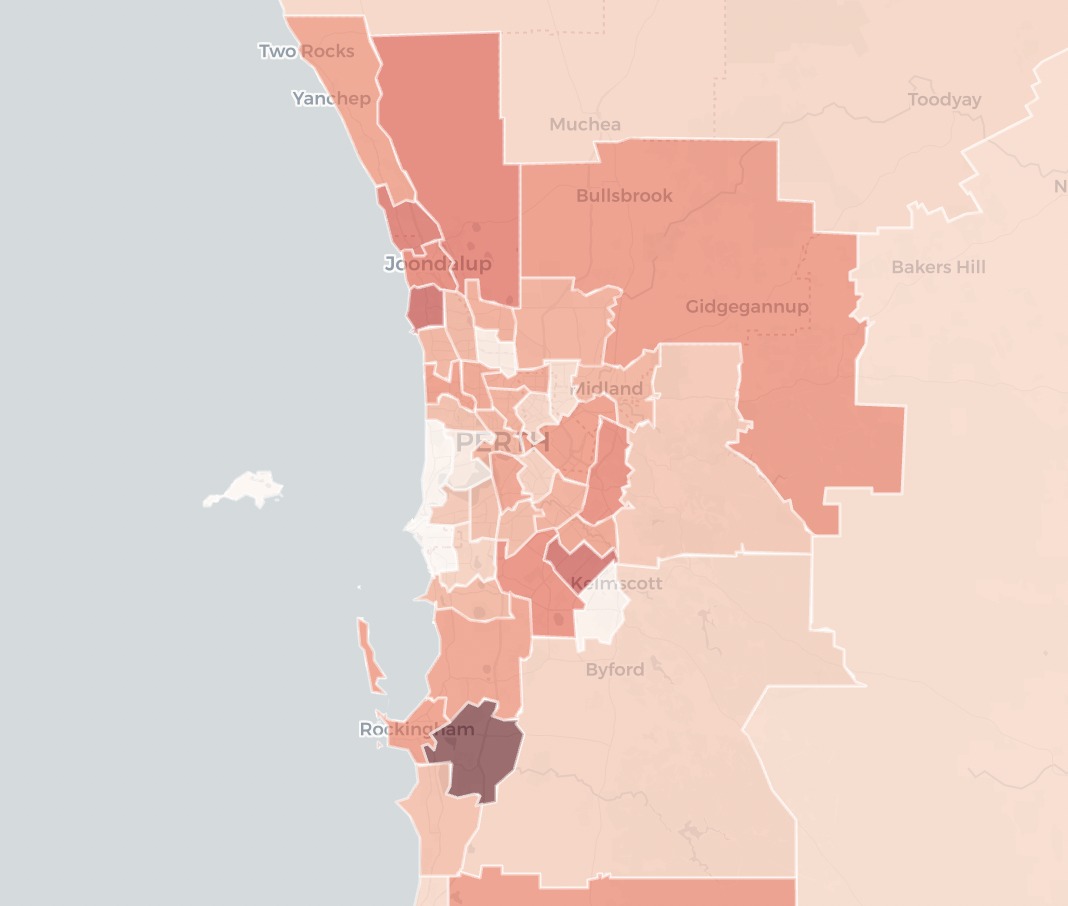The result in the lower house in yesterday’s Western Australian state election was overwhelming and shows how the single-member voting system can produce massive lopsided majorities when a party wins big.
Based on the final results at the end of last night, Labor polled over 59% of the primary vote. We don’t yet have two-party-preferred figures for a handful of seats, but William Bowe at Poll Bludger estimates that we will end up around 69%.
In this post I will give a sense of how the swings varied in different kinds of seats and across the regions of Western Australia, and include a map showing the swings.
Firstly this map contains six different layers. You can toggle between the two-party-preferred swing to Labor (where that is available), primary vote swings for Labor, Liberal, Nationals and the Greens. The map also includes a layer showing the winner of each seat. Seats where Labor is leading or has gained are coloured in a lighter pink, and the one seat where the Nationals are leading is coloured a lighter green. Sorry, some technical issues are stopping me from using legends.
The map of Perth is remarkable, with just Cottesloe sitting alone as a Liberal seat in a sea of red.
This table shows the primary vote swings for each of the upper house regions:
| Region | ALP | LIB | GRN | NAT |
| Agricultural | +13.9 | -7.2 | -1.0 | +4.1 |
| East Metropolitan | +16.6 | -11.0 | -1.7 | |
| Mining and Pastoral | +18.2 | -7.6 | -1.5 | -2.8 |
| North Metropolitan | +18.7 | -12.1 | -2.3 | |
| South Metropolitan | +17.8 | -11.5 | -2.0 | |
| South West | +13.7 | -4.2 | -1.6 | -5.0 |
The swing to Labor was biggest in the metro areas and in the mining and pastoral areas, with the biggest swing against the Liberals in the metropolitan regions.
The Greens also experienced small but consistent swings, with the biggest in the metropolitan regions where their vote is generally higher. I originally thought the swing to the Nationals in Agricultural may have been explained by a redistribution change but it doesn’t appear so. They gained swings in all four electorates in the region, offsetting a much bigger decline for the Liberals.
Another way to look at seats is by where they sat on the pendulum prior to the election.
The pendulum proved to be a good guide for which seats were in the most danger. All eight Liberal seats on margins of less than 8% have fallen. Those in the 10-12% range are both still in play, as is one of the two held by an 8% margin (the other has fallen). Those above 12% survived. The same range of results applied to Nationals seats with similar margins.
I divided seats into the classifications used by the AEC: “safe” represents a margin of 12% or more. “Reasonably safe” covers seats between 6% and 12%, while “marginal” covers those under 6%. The “reasonably safe” category feels a bit silly considering what has happened, but those are the categories.
| Type of seat | # of seats | ALP | LIB | GRN | NAT |
| Marginal Liberal | 6 | 20.8 | -8.8 | -2.4 | 0.3 |
| Reasonably safe Liberal | 6 | 16.6 | -10.7 | -2.2 | -1.7 |
| Safe Liberal | 2 | 8.9 | -6.7 | -0.7 | -7.8 |
| Reasonably safe Nationals | 1 | 15.3 | -8.8 | -1.0 | 1.4 |
| Safe Nationals | 4 | 11.5 | -5.3 | -0.9 | 1.7 |
| Marginal Labor | 11 | 20.0 | -11.0 | -2.2 | -1.9 |
| Reasonably safe Labor | 8 | 21.7 | -13.5 | -2.3 | -1.3 |
| Safe Labor | 21 | 14.6 | -9.2 | -1.4 | -0.6 |
- The biggest swings to Labor took place in three categories: the six most marginal Liberal seats, the marginal Labor seats, and the reasonably safe Labor seats. The two latter categories closely match the seats which Labor won in 2017, where first-term Labor incumbents were facing the voters for the first time. It does fit with the theory that the swing would be concentrated in these seats due to new personal votes. But a similarly big swing was also seen in the most marginal Liberal seats.
- Even in the reasonably safe Liberal seats, the swing may have been less but was still enough to flip most if not all of them. The ALP is leading in all of these seats at the moment.
- The swing was so massive that it touched every part of the state. There is some evidence that Labor did better in more marginal seats, but it did not end up mattering much.




Am more interested in the Legislative Council results. I predict ALP with 22 seats, a historic victory and a magnificent opportunity to reform the LC
Working on it now!
A swing of around 12% in the Metro Area is line ball with what I expected, with 6-8% also being my prediction in Regional WA. What shocks me is some of the individual swings, 24.3% in Joondalup, 13% in Carine, 14% in Bateman, completely ridiculous.
Did a rough count and it looks as though the Liberals will need a uniform 25% swing to win the next election, which is far from an easy task.
Comments are closed.